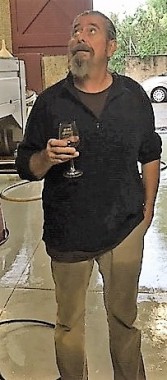I had intended to write about the new developments by Jeff Coutelou to follow the article about the new vineyard at St. Chinian. Sadly, that plan was foiled by the incident at Peilhan which I reported last time. However Jeff’s determination to carry on and continue his plans is undimmed. So, what’s going on?
Let’s start with the regular renewals. Every year vines die off for various reasons, e.g. age, disease and drought. In some vineyards such as Rec D’Oulette where all the vines are Carignan Noir then clearly they are replaced by more Carignan Noir vines. However, the pattern for some vineyards recently has been for Jeff to diversify planting. The model is Flower Power where over twenty varieties are planted, all mixed up. That is what we were doing at St Chinian by adding varieties such as Mauzac and Fer Servadou to the range of vines already in place.
In larger vineyards such as Segrairals and Peilhan there are a number of different areas. In Segrairals for example there were areas of Mourvedre, Cinsault, Cabernet Sauvignon and Syrah. Jeff decided to grub up the Cabernet as it is not a traditional grape of the Languedoc and he replaced it with plantings of Oeillade, Aramon and others.
I have already mentioned that there is a new parcel below Sainte Suzanne which we harvested this year for Jeff’s PetNat, Bibonade. The new vines are Macabeu and Clairette, white grapes which originate in Spain and the local area and will hopefully stand up well to climate change. The Syrah of La Garrigue which goes to make La Vigne Haute in good years is going to be expanded. The parcel next to it has been purchased by Jeff, former vines taken out and ploughed. Syrah vines will be planted there in coming months, the north facing slope helping this southern grape to produce well. All the new parcels need time to grow and it takes three years for them to be also certified as organic.
This type of expansion is not new to Jeff, I reported upon the expansion of Peilhan back in 2015 when I helped to plant the terrace area with varieties such as Morastel, Riveyrenc Noir and Gris, Terret Blanc and Noir and Piquepoul Gris. These vines are now healthy, mature and producing good fruit. The parcels of Ste. Suzanne and La Garrigue will hopefully produce more great wine for us to enjoy.
The most exciting developments though are in the Peilhan vineyard. Jeff has purchased the large plot next door to his existing vineyards and work has begun to transform them. The old vines are torn out and will be replaced with more unusual varieties, this is Jeff’s work after all. At the ends of the rectangular plot trees have been planted already, for example with olive trees, there will be one tree at the end of each set of two rows, roughly 1m-2m apart. On the eastern side various types of tree were planted. Unfortunately these were part of the arson attack two weeks ago and will need to be replanted.
Most spectacularly, to the west a large earth bank has been constructed. It creates a large basin behind which will be lined and used as a water reservoir, storing rainfall. The slope will be gentle in order that wildlife can gain easy access to drink. Jeff described this project to me proudly as his “legacy to the area”. Ironic then that the attack should happen here. Be sure that Jeff will press on and it will be fascinating to watch this project develop.






























































































































